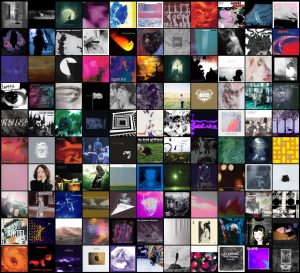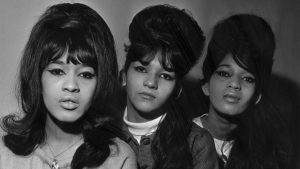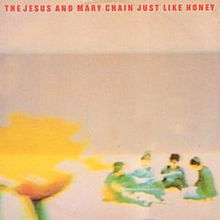Shoegaze: An Introduction
Ride, My Bloody Valentine, and Slowdive, the unofficial big three of the alternative rock darling genre, Shoegaze. Incredibly complex, ethereal, and sometimes difficult to pin down, the genre shoegaze has had a long and complicated history. In this article, I will attempt to trace the history of this genre from as far back as the 1960s to the torchbearers of the modern day. I will explore the bands, the sound, and the production behind seminal songs and albums.
Let’s start by defining the genre; rateyourmusic gives a very straightforward answer. “Shoegaze sound is a wash of instruments blending together. Guitars are typically distorted into droning or feedback-drenched textures, and the group itself strives to create a ‘wall-of-sound atmosphere that takes a noisy, distorted approach and/or a lusher, more ‘dreamscape’ sensation. While vocals and melodies do exist, they are subordinate to the overriding sensation of the song, and melt into the background.”

Shoegaze strikes an interesting dichotomy between the heaviness and distortion of psychedelia and the dreamier side of 80’s pop music to create a wholly unique sound. While this tells us a lot about the sound, the name can be confusing to many fans. The name comes from the often static performances from bands of the genre that would spend more time looking at their shoes (whether it was to match the often repetitive and droney sound or to manage the huge array of effects pedals required to create that sound) than moving around or interacting with the audience.
Shoegaze: Humble Beginnings in the 1960s
The sound of shoegaze is most closely related to the idea of “wall of sound” production which comes from the famous (or infamous depending on how you look at it) producer Phil Spector. The ‘Wall of Sound’ production features layers of instrumentation, leaving almost no room in the mix. The most famous song with this style of production is the 1963 pop smash hit ‘Be My Baby’ by the girl group The Ronettes. The recording of this song featured multiple instruments and numerous overdubs to create a densely layered sound that was still catchy and poppy.

https://www.npr.org/2018/03/12/590891692/its-time-to-recognize-the-ronettes-as-rock-and-roll-pioneers
Another important element of the shoegaze sound is the use of heavy distortion to an almost overwhelming degree. The earliest example of overwhelming distortion is the 1964 rock hit ‘You Really Got Me’ which features some of the earliest, heavily distorted sounds. The story behind this sound is contentious depending on who you believe. Ray Davies claims it was an accident when he stabbed his amplifier, but Dave Davies story is that he purposely modified it; regardless of who’s correct in this debacle, it is certain that this song was not just an influence on shoegaze but on an entire world of heavy music as a whole.
To wrap up the 60’s, why don’t we note back to possibly the most influential band of all time, The Beatles, and their song ‘It’s All Too Much’. According to “The Complete Beatles Recordings”, this original track was eight minutes, and after the initial recording, the band would add overdubs and other layers to give this psychedelic pop song its dense atmosphere. With its heavy distortion and use of layering in the production department, it could certainly be seen as a progenitor of shoegaze. While this was a bold step forward, shoegaze had a long way to go.

Shoegaze: Art-Rock and Ambient of the 1970s
In 1973, art-rock band Roxy Music released the album “For Your Pleasure” which contained the nine-minute song ‘The Bogus Man’. This epic track features wobbly, distorted guitar and reverberated drones to create a truly unique sound that has a connection with the sound of shoegaze.
While not featuring the use of distorted guitar, I think the song ‘I’m Not In Love’ by pop band 10cc has an underrepresented presence in the shoegaze world. The production behind the song is immensely complicated featuring multiple tape loops of vocal samples in different keys. This unique approach to pop production creates a very atmospheric wave of sound that permeates the mix. It shares a lot with shoegaze’s sister genre dream-pop, which is like shoegaze, but minus the abstraction of sound and heavier side that shoegaze normally brings.

https://www.discogs.com/David-Bowie-Heroes-/release/2209502
Roxy Music member Brian Eno would release the seminal Ambient Art-Rock album “Another Green World” which would feature the track ‘Sombre Reptiles’. This song uses an ambient soundscape to explore repetitive distorted drones which would in a sense become a feature of shoegaze. Eno would later go on to produce the David Bowie song ‘Heroes’ a song that the members of the /mu/ board on 4chan would argue was important to the genre. For me, I think this song can absolutely be nailed as a proto-shoegaze song. The use of sharp noisy production, distorted and reverberated guitars, and the dreamy, hazy atmosphere all point to being a proto-gazer song.
In 1979 Wire released the song ‘Map Reference 41°N 93°W’, which took some of the groundwork for the genre and combined it with the sound of post-punk’s vibrant energy, which gave influence to bands like Ride.
Shoegaze: The Sound Blossoms in the 1980s
In 1980 Brian Eno would go on to produce albums for Talking Heads and notably their song ‘Once in a Lifetime’ which was a monumental hit for them. This…was not shoegaze, while it was produced by Brian Eno this was not a proto shoegaze moment. I mention this track as it puts us in the context of the ‘80s sound where New-Wave has risen from the underground of the ’70s and into the spotlight.
In 1981 the band MX-80 Sound would release the song ‘Obsessive Devotion’ a song that would go unnoticed but most definitely took the shoegaze groundwork further by making a hazy and dizzying post-punk track. A band that would further the sound of shoegaze and even in some eyes invent the genre of dream pop was Cocteau Twins with their single ‘Sugar Hiccup’ which takes the sound much slower than the typical sound of new-wave with multiple layers of reverb and drones. The song also can be noted to use one of the first shoegaze sound techniques of having the vocals at the same level as the rest of the instruments creating a hazy and rich sound.
Another band of the Ethereal Wave/Dream Pop variety was This Mortal Coil who experimented with sound on the track ‘Sixteen Days/Gathering Dust’ which takes a more gothic/post-punk approach to the more ethereal sound of Cocteau Twins. This song reflects the use of noise and sound that would become commonplace in the sound of the genre.
In 1985 it would be possible to say that shoegaze was invented by The Jesus and Mary Chain (check out our TTT on them) when they released their single ‘Just Like Honey’. When describing the respective album this single comes from Rolling Stone says “The Mary Chain’s debut is a decadent masterpiece of bubblegum pop drowned in feedback” which might be a perfect description of shoegaze.

https://en.wikipedia.org/wiki/Just_Like_Honey
The song features all of the elements of a shoegaze track. Heavily distorted guitar, wall of sound production, dreamy atmosphere, and low mixed vocals. It could be said that this was the first shoegaze song. The song that sparks no debate however is A.R Kane’s ‘When You’re Sad’. While A.R Kane was not trying to be like The Jesus and Mary Chain they somehow invented an unmistakable sound with this track. With wailing distortion and heavy reverberated noise, this song is most definitely fitting.
The late ’80s would have its share of shoegaze-Escue songs like the dreamy sound of Spacemen 3 and their song ‘Take Me To The Other Side’ or the indulgent heaviness of Dinosaur Jr. on the song ‘Little Fury Things’. While these songs had the elements of the sound they weren’t really shoegazing. The genre wouldn’t be etched into musical stone until 1988 when My Bloody Valentine released the song and EP ‘

https://en.wikipedia.org/wiki/Kevin_Shields
you made me realise”(yes it is spelled wrong and is all lowercase).
The creation of this sound took many forms but mostly by messing with a reverse reverb effects pedal to create a different sound. Kevin Sheilds (guitarist for MBV) also credits marijuana to the creative process of the EP. Another important part of this song is the live performances. According to Pitchfork, the song would be extended both in length and volume to create an ear-splitting noise that would become a staple in the heavier and more intense side of shoegaze.
Shoegaze: An Evolution
From this point, shoegaze would take off. In 1990 Bands like Ride would add speed and intensity to distance themselves from the slower side by incorporating Britpop elements on songs like ‘Seagull’. In 1991 My Bloody Valentine would release the monumental album “Loveless” which has one of the most famous shoegaze songs ‘When You Sleep’ which adds even more layers of distortion but cuts back the dissonance to create an incredibly hypnotic and rich sound.
The band Medicine would turn up the noise elements on a song like ‘Never Click’. The band Smashing Pumpkins would land a major radio hit with the song ‘Today’. Slowdive would call back to the sounds of Cocteau Twins with their more dream-pop take on the genre with songs like ‘Alison’
So after the early ’90s where did shoegaze go? Shoegaze didn’t disappear it more or less worked its way into other genres but most specifically metal. Take Starflyer 59 who creates an amalgamation of My Bloody Valentine and Black Sabbath on ‘Blue Collar Love’. Hum would blend Post-Hardcore and Space Rock with shoegazing to make the song ‘Stars’. In 1997 Deftones would blend the nu-metal and alternative metal sounds with dense layering on ‘Be Quiet and Drive (Far Away)’.
Now the shoegaze scene belongs to the indie community. Bands like Sweet Trip are taking the sound in a new direction by applying the production style to a folksy indie rock sound on songs like ‘Milk’. Deafheaven are taking elements of black metal and post-rock to create blackgaze, a genre that strikes a balance between uplifting distorted melodies with lowly mixed screeches on ‘Dream House’. Even in 2021 bands are still using this sound, Korean band Parannoul is taking shoegaze back to its pure ‘90s sound on songs like ‘Beautiful World’.
In conclusion, shoegaze has had a complex and long history of sound, equipment, and people. I have created a playlist that has every song I mentioned in this article linked here. Maybe you will discover a new band or possibly even be inspired to take the genre in your own direction. Whatever you do hopefully you learned that what is simple might be more complex than you ever thought.






